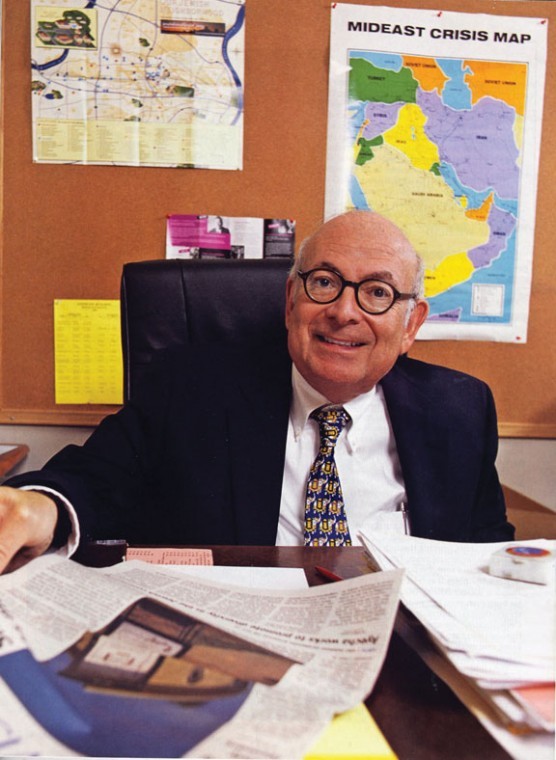Cohnipedia: The story of Forest Park’s Jewish monument
Published July 13, 2011
Welcome to “Cohnipedia,” a new column suggested by Larry Levin, CEO/Publisher of the St. Louis Jewish Light, based on a funny gift I received from the staff four years ago on my 40th anniversary at the paper. In a clever parody of “Wikipedia,” the Light staff prepared a mockup of a “Cohnipedia: intro page, which bragged about the “legendary memory” and tendency of yours truly to “go historical”.
My late Mom, Lillian DeWoskin Cohn, who also had a good memory, was more blunt. She would say, “Bobby you are an encyclopedia of useless information.” Anyway, at least some of that information has proved to be useful, and Cohnipedia will focus on specific persons, places or events about the 200+ years of St. Louis Jewish history. We hope that Cohnipedia, which will appear twice a month online at www.stljewishlight.com will be “interactive,” and I have already received several good suggested topics from readers. Please keep them coming. Here is a sample of the kind of topics we will be discussing:
Did you know that right across the street from the Chase-Park Plaza Hotel, in a corner of Forest Park, there is a strikingly beautiful monument to the Tercentenary of the American Jewish community? Next time you are in that neighborhood, check it out.
In 1954, when American Jewish leaders, including the late Rabbi Ferdinand M. Isserman of Temple Israel, were eager to commemorate the 300th anniversary of the arrival of the first 23 Jews from Recife, Brazil in what was then called New Amsterdam, the visionary rabbi came up with the idea of putting up a permanent monument to mark that event. The 23 Jews were escaping from the Portuguese Inquisition in what was then Portugal’s colony of Brazil.
Rabbi Isserman enlisted the help off longtime civic and philanthropic leader Howard Baer, who was at first skeptical about putting up a monument in St. Louis to an event that happened 300 years earlier in New York. But Baer, whose own vision would later inspire him to successfully organize the Zoo-Museum District, came on board, and raised the funds needed to construct the impressive monument.
“I have learned,” said Baer, “that as history recorded the great achievements of those early settlers who gained freedom of worship not only for Jews, but for all religions…that this monument is a credit to all St. Louis.”
The impressive monument, which was formally dedicated to St. Louis in 1956, features a marker with a flagpole on a Modernist stone base on which are engraved Biblical quotations relating to Franklin D. Roosevelt’s famous “Four Freedoms” enjoyed by Jews for the first time in the “Goldene Medina” of America. A small fountain adjoins the flagpole. The section of Forest Park along Lindell Boulevard is right down the street from the old Temple Israel building on Washington Avenue.
Fast forward to 1989, when then Jewish Federation honcho Bill Kahn visited the site and was alarmed that over the years it had fallen into disrepair. Kahn contacted Howard Baer, then 87 years old, to enlist his support in a successful effort to raise $275,000 to restore the Tercentenary Monument to its former glory. Among the major benefactors who generously supported the effort were Lucy and the late Stanley Lopata, longtime major supporters of Jewish and general causes, and Ted and Nancy Koplar, whose donation made possible the fountains situated on the west side of the monument. The section of Forest Park on which the monument is located was renamed the Lopata Plaza in honor of the couple’s support.
As a result of the collective vision and generosity of Kahn, Baer, the Lopatas and the Koplars, a fully restored monument to the Tercentenary of the American Jewish community was re-dedicated on Sunday, Oct. 29, 1989.
Over 200 people, including members of the family of the late Rabbi Isserman, attended the dedication, which was addressed by Tom Green, then President of the Jewish Federation and the late former Missouri Senator Thomas F. Eagleton, pinch-hitting for his friend Senator John C. Danforth, who had a schedule conflict. Rabbi Isserman had endorsed Eagleton when he first ran for public office, and he was eager to recall that valued support.
“Why, in 1954, did Rabbi Isserman consider a monument to the original 23 Jewish settlers so important to St. Louis?” asked Eagleton.
He then went on to explain: “Rabbi Isserman was a great supporter of civil liberties for people of all religions and from all places. He worshipped not only the Old Testament and the Torah, he worshipped our Bill of Rights, which we will celebrate its 200th birthday two years from now. Indispensable to that Bill of Rights if Freedom of Religion.”
By the way, Forest Park has several other Jewish-related gems in its history. Back in 1904, when the park was the main venue for the St. Louis World’s Fair, the first time in history that the Zionist (and future Israeli) flag flew over a public building was over the Fair’s Hall of Nations. There is also the Nathan Frank Bandstand, named after the only Jewish person from St. Louis to serve as a member of the U.S. Congress.
If your eyes have not “glazed over” by now, I know that you are interested in local Jewish history. There is much more to come, and I do encourage you to respond with your own questions about the topic and suggestions for future columns.
And the rest, as they say, is “history.”
Email Robert A. Cohn at [email protected].















